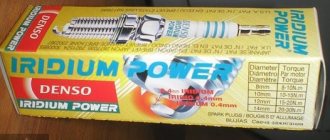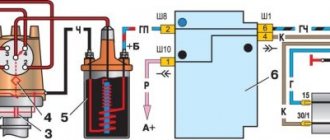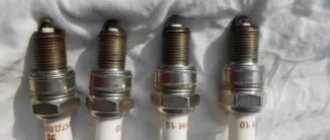The engine is the heart of any car, and spark plugs are, of course, one of the main indicators of its proper operation. It is because of their malfunction that the engine may not start at all. The most common problem with candles is black soot. If it appears, the driver’s main task will be to identify and eliminate the cause, since this determines the performance of the vehicle.
Causes of black soot
Causes of black carbon deposits on spark plugs
A frequent question from owners of the VAZ-2114 car is, why does black carbon appear on the spark plugs? And the reason for its appearance is an increased level of gasoline in the air-fuel mixture.
This is due to the following factors:
- Malfunction or incorrect setting of the carburetor (on a VAZ-2114 it is a very rare occurrence to encounter a carburetor);
- The air filter is clogged and requires cleaning or replacement;
- Malfunction of the engine fuel regulators, resulting in increased fuel supply;
- Reduced compression level (cylinder pressure);
- Spark plug faulty.
Also, problems may arise if oil pores are deposited on the spark plug due to its penetration into the combustion chamber.
Diagnostics of VAZ-2114 engine operation
First of all, in case of engine malfunction, i.e. If it does not start, you need to check the spark plugs.
If black carbon deposits are detected during the inspection, first of all you need to find out the nature of its manifestation, what caused it, excess gasoline or oil, or perhaps just a weak spark of a spark plug.
Soot, in turn, is of two types:
- Oily . It appears in the places of threaded connections and in particular on the electrode itself, and also causes the appearance of blue smoke instead of standard exhaust gases.
Oil deposits on spark plugs
For full diagnostics, new spark plugs are used. After installing them, the car should travel 100-150 kilometers , based on further indicators of the spark plugs, it is already possible to judge the presence of malfunctions.
Possible reasons for the appearance of soot
Before answering the question of why the candles are black, you need to decide how exactly they turned black . After all, it depends on which direction to search. In particular, the candles can turn black all together, or maybe only one or two of the set. Also, the candle may turn black only on one side, or perhaps along its entire diameter. There are also so-called “wet” and “dry” carbon deposits.
It should be noted that the speed of appearance and nature of carbon deposits directly depends on existing faults (if any):
- Carbon deposits on new spark plugs begin to form after at least 200-300 km. Moreover, it is advisable to drive along the highway at approximately the same speed and engine load. This way the spark plugs will work in optimal mode, and it will be possible to more objectively assess the condition of the car’s components.
- The amount and type of soot depends on the quality of the fuel used. Therefore, try to refuel at trusted gas stations, and not drive with gasoline or similar mixtures. Otherwise, it will be difficult to establish the real cause of the appearance of soot (if it occurs).
- In a carburetor engine, the idle speed must be set correctly.
Now let's move directly to the question of why black soot appears on the spark plugs. There may be 11 main reasons :
- If you notice blackening on only one side, then most likely this is caused by a burnt-out valve. That is, carbon deposits on the spark plug fall on the side electrode from below (and not on the central one).
- The cause of black spark plugs may be a burnt-out valve. The situation is similar to the previous one. Carbon deposits may penetrate the bottom electrode.
- An incorrectly selected glow rating of a spark plug causes not only damage to it during further use, but also uneven blackening at first. If the mentioned number is small, then the shape of the soot cone will change. If it is large, then only the top of the cone will turn black, and the body will be white. Heat number is a value that characterizes the time during which the candle reaches glow ignition. With a higher heat number it heats up less. Install spark plugs with the heat rating specified by the manufacturer into the engine.
- A uniform black coating on the spark plugs indicates late ignition.
- Black plugs on the injector or carburetor may appear due to the fact that the air-fuel mixture they produce is too rich.
As for the first, there is a high probability of incorrect operation of the mass air flow sensor (MAF), which provides information to the ECU about the composition of the mixture. It is also possible that the fuel injectors have become depressurized. Because of this, gasoline enters the cylinders even when the injector is closed. As for the carburetor, the reasons may be the following factors - incorrectly adjusted fuel level in the carburetor, depressurization of the needle shut-off valve, the fuel pump creates excess pressure (the drive pusher protrudes strongly), depressurization of the float or its touching the chamber walls. “Dry” carbon deposits on a candle - Significant wear or depressurization of the power mode economizer ball valve on carburetor engines. That is, more fuel enters the engine not only in power modes, but also in normal modes.
- The cause of a black spark plug may be a clogged air filter. Be sure to check its condition and replace it if necessary. Also check the choke actuator.
- Problems with the ignition system - incorrectly set ignition angle, violation of the insulation of high-voltage wires, violation of the integrity of the cover or distributor slider, malfunction of the ignition coil, problems with the spark plugs themselves. The listed factors can lead to interruptions in sparking, or the occurrence of a weak spark. Because of this, not all the fuel burns, and a black glow forms on the spark plugs.
- Problems with the engine valve mechanism. In particular, this may be burnout of the valves, or their unadjusted thermal clearances. The consequence of this is incomplete combustion of the air-fuel mixture and the formation of carbon deposits on the spark plugs.
- In injection cars, it is possible that the fuel regulator has failed and there is excess pressure in the fuel rail.
- Low compression level in the cylinder to which the black spark plug corresponds. You can read how to check compression in another article.
As a rule, when the ignition is set late and the air-fuel mixture is rich, the following consequences arise:
- misfires (error P0300 appears on injection engines);
- problems starting the engine;
- unstable engine operation, especially at idle, and as a result, increased vibration levels.
Next, we will tell you how to eliminate the listed faults and how to clean the spark plugs.
Rich mixture
For combustion without residue, the mixture must meet certain limits in terms of the ratio of oxygen and gasoline vapors in it. And not only in steady, stationary mode, but also in transient modes, that is, during acceleration, warming up, engine braking, idle and power modes. There may be not enough oxygen or there may be a slight excess, but in any case, during normal engine operation, the spark plugs should not turn black. The appearance of black soot on the spark plugs indicates incomplete combustion of fuel, which means either too much of it is supplied, or there are difficulties in supplying the required amount of air.
This is interesting: Transfer case oil: properties, how to choose, how to replace
The reasons for abnormal over-enrichment of the mixture can be very diverse:
- overflow nozzle or misregulated carburetor metering system;
- air filter clogged with dust;
- incorrect operation of sensors or oxygen feedback of the engine management system;
- abnormal pressure in the fuel rail;
- the consequences of illiterate tuning when trying to get an increase in power by simply enriching the mixture.
In this case, the candle will be evenly covered with a velvety black coating of classic soot, most reminiscent of uncleaned stove heating chimneys. And since pure carbon is an excellent conductor of electricity, the energy of the spark will flow through this graphite, and the ignition will stop.
Poor self-cleaning
The candle must be in thermal balance mode, that is, have a temperature of the insulator and electrodes at which the soot that falls on them burns out in the presence of oxygen. If the temperature is insufficient, then even the presence of an oxidizing agent will not help. This happens if the engine is loaded without allowing it to warm up. In power mode, the mixture is enriched, carbon particles are released, fall on the candle, and do not have time to burn out. If you do not allow sparking to occur, then eventually the temperature will rise and the excess soot will successfully burn.
But it is quite possible that the interruptions will begin earlier, the temperature will drop even more, the spark plug will fail, and the owner will be presented with black spark plugs, the reason for which is similar to the previous case.
Heat number discrepancy (CN)
It is the CN that determines the operating temperature of the spark plug, being responsible for both its anti-knock properties and self-cleaning. This number cannot be increased, since too hot electrodes will become a source of abnormal combustion, and it is undesirable to lower it due to the tendency of the spark plug to be filled with hydrocarbons. Therefore, the CV is very carefully selected for each specific engine on stands and is indicated in the form of a recommended type of spark plug or its analogues with the same properties. Ignoring these requirements is fraught with problems, even destruction of the engine. Well, a spark plug that is simply “cold” for a given engine will quickly become covered with unburned carbon. Sometimes completely, and sometimes - separately the electrodes or only the upper part of the insulator. It is always colder because it is in contact with the body and is located further from the combustion source.
Misfires
They do not always depend on the candle. This could be a half-dead ignition coil, high-voltage wires with leaks, weak pulse parameters in terms of voltage and rising edge, and so on, there are a lot of reasons. Ideally diagnosed with an oscilloscope, although there are simpler methods. In any case, the spark plug will cool down, which will reduce the situation to the one described above.
In fact, the ignition system alone cannot be blamed for misfires. As popular wisdom says, there is either nothing to burn, or nothing to set on fire. And you can also add mechanical problems. Diagnostics to help. And the control system computer can provide data on the number of cylinder misfires; it constantly and diligently counts them, typing giant multi-digit numbers in the event of a malfunction.
Loss of compression
For high-quality combustion of the mixture, it must first be highly compressed. If the compression is, for example, 12 , then this means that the pressure at the moment of ignition 12 times greater than atmospheric pressure. When this parameter decreases from the norm, not only do combustion conditions worsen, but also some of the working gases in the most unpredictable composition leave the combustion chamber due to insufficient mixing of gasoline with air. Among other troubles, this will lead to the appearance of black spark plugs, which is caused by mechanical problems. Moreover, with an uneven geometric location. A burnt-out valve may show a characteristic torch, or coked spark plugs and a scored cylinder mirror will leave their mark in the form of one-sided coloring of the insulator.
Late ignition
The combustion rate of the mixture is limited to a very specific value, depending on its qualitative composition and degree of compression. If combustion is initiated too late, and not a few degrees before top dead center, as expected, then the charge does not have time to burn out completely, going through the exhaust valve to heat the exhaust system and leaving black soot on the spark plugs. Early ignition is even more harmful to the engine, but it does not color the spark plugs. Rather, it simply destroys by detonation.
Unsuitable gasoline
This problem is similar to the previous one. Fuel with different octane numbers, in addition to differences in resistance to detonation, has different burning rates. And if the engine cannot adapt to large deviations, then the effect will be the same, accompanied by a violation of the thermal regime of the spark plugs.
But in addition to detonation properties, the fuel may simply be of poor quality. All kinds of counterfeit gasolines of criminal distillation contain heavy fractions of oil and other impurities that are unsuitable for use in a modern engine. The soot from this entire set will be deposited on the candles, coloring them in an already known color and quickly rendering them inoperative. And attempts by manufacturers to give the counterfeit detonation resistance with the cheapest additives in large quantities will additionally provide the insulators with a red tint. It is also conductive, so such a candle will no longer work normally.
This is interesting: How to independently restore studs on studded winter tires
Spark plug defects
Both breakdowns and fatigue of materials that occur during operation, as well as initial manufacturing defects, make the spark plug unsuitable for stable operation. All this leads to the already discussed case of misfire with all the consequences. The most common is to increase the gap between the electrodes. The metal gradually burns out, the spark gap grows and goes beyond reasonable limits. Eventually, under certain conditions, the discharge voltage begins to be insufficient for breakdown, and the charge leaves along an easier path, through the outside air or flowing down the insulator. Which, in turn, is covered with conductive deposits on a worn spark plug.
A similar case will be when the spark plug was initially selected in violation of factory recommendations. Most often this happens in the pursuit of car enthusiasts for multiple electrodes. This is supposed to increase the power and reliability of the spark discharge. Yes, some companies use such spark plugs from the factory. But there are no more than two side electrodes, and the use of this feature by a well-known company does not change the controversial issue at all. Manufacturers are not always guided by technical expediency. In practice, multi-electrode spark plugs do not bring anything good. Developed side electrodes shield the discharge from the fuel mixture, reduce the reliability of sparking and cause the formation of soot.
In addition to stationary processes leading to contamination of spark plugs with black deposits, there are cases of one-time carbon coating. For example, separating large pieces of carbon deposits from the piston bottom, starting the engine at extremely low temperatures, or throwing oil into the combustion chamber once. Over time, the candle will clear. But the question arises: is it necessary to clean the spark plugs covered with soot as the cause of its formation is eliminated, or does it make sense to replace them as a set with new ones? If the spark plugs are the most common ones, based on nickel alloys, then their reliable service life does not exceed tens of thousands of kilometers. This set needs to be changed. But if it is expensive platinum and iridium, then such devices are characterized by increased durability. After careful cleaning, preferably using a specialized sandblasting machine, such a spark plug will be no worse than a new one, and the savings will amount to a decent amount.
Repair recommendations
Regarding repairs, we will consider each case individually, since individual faults and types of soot indicate the need for different types of repair work .
Oily black soot
The appearance of oil deposits indicates the penetration of oil into the combustion chamber. Accordingly, it is necessary to thoroughly study the condition of all components that could cause such a defect, and, if necessary, replace them. These components are :
Guide bushing wear
Wear of valve stem seals
The problem relates strictly to the wear of components of the cylinder-piston system. Accordingly, they must be replaced.
Dry black carbon
Regarding the second type, there are several more reasons than in the case of oil deposits . And it is impossible to clearly understand which one is causing the soot without checking each one.
- The first, easiest to check is a faulty spark plug, or lack of energy in it, the solution to the problem is to replace the spark plug.
Changing the spark plug
We measure the compression in each cylinder
Adjusting the fuel pressure
Cleaning the air filter
Checking for errors
Erosion
Prolonged operation of the engine on spark plugs that have exhausted their service life leads to the appearance of traces of erosion on their electrodes. Symptoms that are observed in the behavior of the engine are instability at idle, decreased power, and constant tripping.
In addition to non-compliance with the intervals for replacing spark plugs, a likely reason that explains everything that is happening may be the use of gasoline, which contains tetraethyl lead. Replace the spark plugs and switch to higher quality fuel and these problems may go away.
conclusions
There are many reasons why black soot may appear on the spark plugs of a VAZ-2114 engine, the main thing is to notice all the malfunctions in time and prevent them in time, which is not difficult.
By following a number of rules, you can avoid the appearance of black soot.
To avoid such problems, follow these rules:
- Keep the air filter clean.
- Make sure the engine is set correctly.
- Do not neglect the timely replacement of components of the cylinder-piston system.
- Keep the pressure stable.
By following these simple rules, you can avoid and even prevent the presence of soot on candles, and forget about its existence forever.
Black soot
Black velvety soot
If you find a velvety layer on the candle, which is black carbon deposits, you can confidently speak about an overly enriched mixture. The most common causes of over-enrichment include incorrect adjustment of a carburetor engine or a malfunction of the computer if we are talking about an injection-type engine. Interruptions could also be caused by a broken lambda probe, a clogged air filter, or a malfunction of the air damper mechanism.
How to diagnose spark plugs based on appearance: black carbon
A dark, opaque coating on the electrodes can indicate numerous problems. Before analyzing them, let us divide black formations according to their structure into three independent groups:
- Oily (wet deposits).
- Velvety or loose (dry soot).
- Solid.
Oily texture
In response to the presence of oily deposits, diagnostics of spark plugs based on the appearance of the insulator will issue an expert conclusion - oil is entering the combustion chamber. Electrodes are wet due to lubricant - major repairs cannot be avoided. The situation shown in the photo can happen for three reasons:
- Valve seals are worn out.
- The life of the piston rings is coming to an end.
- The valve guides are broken.
Compression measurements will help separate the culprits. If it is normal, then the problem is related to the tightness of the valves. The following aspect also has the right to life: the thread in the oil is the reason in the cylinder head (with bushings/valve caps). It is possible that lubricant may leak from under the valve cover through the spark plug well.
In parallel with the deposition of oil on the electrodes of the spark plugs, the muffler emits white-blue gases. Another possible symptom is the power plant tripping at the beginning of warm-up.
For reference. A particular variation of the signs of an oil-air emulsion entering the combustion chamber is ash deposits. This deposit occurs due to the combustion of the additive package included in the oil by the manufacturer. If this fact is discovered, the rings should be decarbonized.
Loose black dry soot
Velvety black color primarily indicates increased fuel consumption. It may be caused by improper carburetor adjustment. On an injection engine, the reason may lie in the malfunctioning of the ECU, associated with incorrect readings of some sensors. A clogged air filter will also cause the mixture to become over-rich.
A matte, loose black coating also appears during prolonged operation of the internal combustion engine at idle or short trips within the city. It is noteworthy that this structure is formed only on the electrodes. The thread remains clean. More detailed reasons are considered separately for the methods of preparing fuel assemblies and will be given below.
Hard black deposits
Such deposits indicate one thing - the spark plug does not correspond to the engine in terms of temperature characteristics. In other words, the igniter has too high a heat value. In fact, this indicates that the product is “cold”, that is, its self-cleaning temperature in the combustion chamber is not reached.
Origin of red plaque
This phenomenon is less common than the effects described above. Why are there red electrodes on some spark plugs?
- the tank is filled with low quality gasoline with additives that increase the octane number;
- a car enthusiast or a fuel supplier adds additives to gasoline, which contain a large amount of metals;
- the owner of the car installed spark plugs in the cylinders that did not match the heat rating.
The reasons for the reddish tint of spark plugs do not pose a direct threat to the power unit, but are harmful in the long term.
Driving on low-quality gasoline with unknown additives a priori accelerates the wear of parts and components. Plus an increase in consumption arising from worsening combustion conditions of the mixture in the cylinders. Operating a car with spark plugs that are “cooler” or “hotter” in terms of heat rating reduces engine power and significantly shortens the life of the elements. A characteristic sign of incorrectly selected spark plugs is a drop in crankshaft speed at idle and missed ignition cycles.
White carbon deposits on the ignition system elements
The gradation of electrode colors from light gray to white (light yellow is also possible) is evidence that the engine is running on a lean mixture. Related reasons may be:
- The product is too hot. The heat rating of the product is lower than that recommended by the manufacturer.
- Large ignition timing angle.
- Using low octane gasoline.
There is no point in delaying in finding out the circumstances that caused this soot-colored condition on the new spark plug. A lean mixture directly causes overheating of both the igniter and the combustion chamber. Ultimately, this situation can lead to burnout of the exhaust valves.
When analyzing the factors that caused a poor quality mixture, it is useful to check for the presence of abnormal glow ignition. A symptom indicating its presence is the reluctance of the engine to stall when the ignition is turned off. In total, this means that the “match” was not created for this engine. This conclusion will not be spontaneous if the heat removal from the igniter is not impaired due to loose tightening of the threaded connection, and there is no dirt under the sealing gasket. If this is the case, then you will have to buy a new kit, after consulting the instruction manual.
Light electrodes
White or light gray spark plugs in all cylinders are a sign of a lean air-fuel mixture supplied by the injector or carburetor. Moreover, the skirt, area near the electrodes and the threaded part are absolutely dry, without traces of oil.
Why is the fuel mixture supplied lean?
- lambda - the probe incorrectly informs the control unit about the amount of oxygen in the exhaust gases, the reason is sensor wear;
- faulty or clogged nozzles;
- incorrect carburetor settings or clogged fuel jets;
- insufficient pressure in the injector fuel rail;
- problems with the idle air control;
- air leakage under the manifold or in another place;
- unsuccessful chip tuning of the controller made by the owner of the car.
A lean mixture does not pose any particular danger to a running engine, but it does cause discomfort to the driver. The car accelerates slowly, pulls poorly and jerks - there is a lack of fuel. Oddly enough, the phenomenon causes increased gasoline consumption - a car enthusiast who wants to achieve better performance indicators presses the accelerator pedal harder and more often.
Note. Often the light shade of the working electrodes is explained by the type of fuel used. If the car is operated on methane or liquefied gas (propane-butane mixture), this color is considered normal.
Extreme conditions of spark plugs
Metal dust, oil, gasoline
The presence of oil, drops of gasoline and small metal fractions on the electrodes is an indication that the cylinder is not functioning. The culprit is either a damaged valve or broken partitions between the piston rings. Parallel symptoms:
- Constant tripping of the engine.
- Significant loss of power.
- Double increase in appetite.
Destruction of the central electrode with a ceramic insulator
Prolonged operation in detonation mode and low octane fuel are the key causes of the crash. However, one should not write off defects in the manufacture of the product and incorrect operation of the mixture ignition system. At the same time, the engine runs rough, eats a lot and delivers power poorly.
The situation is actually dangerous, especially for internal combustion engines running on propane. When performing a spark plug inspection and discovering this unsatisfactory appearance, it should be taken into account that electrode particles may become stuck under the exhaust valve. This is fraught with repair of the cylinder head.
Ceramic skirt failure and erosion
The insulator can be destroyed only due to defective or improper handling of the candle. For example, the arsonist was unscrewed from a hot engine and dropped into cold water or simply released from his hands at a certain height.
Erosion occurs due to non-compliance with the spark plug replacement interval and excessive bending of the side electrode. It can also be caused by driving on leaded fuel. In this case the motor:
- Doesn't start well.
- Functions unstable even after warming up.
- Troit.
- Misfires.
- Does not provide adequate power.
The spark plug is filled with gasoline
This scenario often occurs due to a malfunction of the ignition system or because the carburetor/injector is leaking. It is likely that you will need to clean the injector yourself using special means.
However, in winter this phenomenon can occur due to the fact that gasoline does not have time to evaporate and settles on the electrodes. In this case, the engine will not start until the spark plugs are cleaned in alcohol and properly dried. It is worth drying in a gentle mode so as not to damage the insulator. A hair dryer and high oven temperature are not suitable.
Ash and erosion
Ash deposits are also a consequence of lubricant ingress. But the amount of lubricant that has penetrated into the cylinders is not yet very large, so it burns, releasing a large amount of wear products that settle on the electrodes in the form of ash.
Erosion on spark plug electrodes (clearly visible defects and traces of melting) occurs in two cases:
- The first is the exhaustion of the life of the spark plugs, which causes interruptions in their operation and deterioration in spark formation. If you continue to operate the car on such spark plugs, then due to interruptions the combustion process changes, which is the cause of melting.
- The second case is the presence of tetraethyl lead in gasoline. This additive affects the combustion process and, as a result, the spark plugs. In this case, it is enough to replace the fuel and spark plugs.
Known causes of black carbon deposits on spark plugs or what is wrong with the engine carburetor
A dark, loose coating indicates that the mixture is over-enriched with fuel. Soot also occurs due to short trips around the city or excessive “rattling” at idle. To know for sure that the problem lies in the carburetor settings, you need to install a new set of spark plugs and drive 100-200 km along the highway. Only after this can diagnostics be carried out.
We will discuss what causes black carbon deposits on the spark plugs and the carburetor along with the reasons for its malfunctions in the following subsections:
- Clogged air jets of dosing systems.
- The quality of the fuel composition, which is adjusted with a special screw, is incorrectly set.
- The economizer ball valve has expired or lost its tightness.
People's experts often blame an increased level of gasoline in the float chamber. The phenomenon occurs under the following circumstances:
- Incorrect level setting.
- Leaking needle shut-off valve.
- Loss of tightness of the float or it touches the walls of the chamber.
- The fuel pump produces excess pressure (the drive pusher sticks out strongly).
Red soot
Of red color
Plaque on spark plugs with a characteristic red tint is formed due to the operation of the power unit on gasoline, which contains lead and other metal compounds. They are called additives and are additives that are mixed with fuel to increase the octane number.
Thus, normal spark formation during prolonged operation of the internal combustion engine on so-called leaded gasoline is completely disrupted, which is why red soot is a serious reason to think about deeper engine diagnostics at a trusted service center.
Replacement frequency
Each part has its own service life. After it expires, there is a decrease in productivity or complete failure. It is necessary to follow the recommendations of car manufacturers, who set a mileage limit after which a replacement set of spark plugs is required.
Poor condition is often easy to identify visually. Upon careful inspection, in addition to traces of soot and soot, a change in the gap between the electrodes of the product may appear. Also, under different circumstances, the shade of plaque can be different. It is sometimes used to determine the type of problem.
Gasoline traces
If during operation the spark plugs are constantly filled with gasoline, this indicates a malfunction of the injector or carburetor ignition systems. To be absolutely sure that these elements are not functioning correctly, it is worth installing a new set of spark plugs. If during their next inspection it turns out that they are covered with gasoline, repairs cannot be avoided.
Why are spark plugs black?
One of the main reasons for blackening is chemical and thermal exposure in an aggressive environment. When such problems are constantly identified, it is worth carrying out a thorough diagnosis, since failures inside the combustion chamber are often associated with removable factors:
- use of low quality fuel;
- temperature imbalance;
- penetration of foreign substances into the cylinders;
- failures in fuel system settings, etc.
As a result, the quality of sparking decreases. The process affects the power parameters of the car, and also contributes to the rapid wear of systems and components.
There are simple ways to test for carbon deposits . The options are relevant both for engines that have a carburetor, and for engines in which manufacturers have installed an injector.
For monitoring, you will need a new spark plug that has proven performance characteristics. First, we unscrew the problematic SZ from the mounting socket. In its place we screw in a new, proven SZ. You will need to drive about 200 km, after which we remove the spark plug from the control socket for checking.
It is important to know that carbon deposit monitoring must be carried out on a well-warmed engine.
Frequency of replacement of ignition elements
Automakers provide specific recommendations on how often spark plugs need to be checked and replaced. Let us clarify that the data indicated in the technical documentation is somewhat exaggerated by the manufacturer, and motorists are forced to change them more often than stated. If you suspect wear or poor condition of the spark plugs, you can determine their condition quite easily by carefully examining the shade of soot formed on the surface of the electrodes. This allows you to determine which systems and components of the vehicle lead to incorrect operation of the elements.
This is interesting: Engine mounting: principle of operation, purpose, design and replacement
Velvety coating
In some cases, motorists notice black carbon deposits on spark plugs in the form of velvety particles of soot. There are no oily smudges. This fact indicates that an excessively rich air-fuel mixture penetrates into the cylinders. In engines with a carburetor, fuel deposits settle on the electrodes. The reasons are:
- incorrect carburetor settings or unstable operation;
- problems with solenoid valves;
- insufficient sparking;
- reduced level of compression in the cylinders;
- air filters are excessively dirty.
We recommend diagnosing these systems in both domestic and foreign cars. The symptoms are the same in both of them.
The operation of injection engines is associated with high pressure in the fuel system. Due to excess stress present in the frame, the mixture may be over-rich. Excess fuel penetrates the cylinders, and the pressure stabilizer also malfunctions.
In addition to the reasons listed, there may be manufacturer defects if you purchase counterfeit products without certificates. We recommend checking the ignition coil settings, timing, and also testing the quality of the valves, wear of the piston rings and the absence of condensation in the block.
Soot color - what does it mean and what to do?
Take a close look at the spark plugs. Their color will help you understand a lot... For example, you will be able to identify problem areas of the car. It is not enough to just replace the problematic element; look deeper and look for the cause. If it is not corrected, the new spark plug will very quickly become unusable. The problem needs to be cut to the root. The first step is to deal with the ignition system. The next step is to look at the candles. Determine what color the resulting plaque is. Highlight:
- black
- red
- white
Each of them indicates the presence of one or another problem.
Black soot
This type of soot occurs for a number of reasons. There are two subspecies:
- Dry;
- Oily.
Black and dry carbon deposits are applied to the spark plug due to an overly enriched mixture. This could have been preceded by:
- Incorrect carburetor operation;
- Air filter clogged;
- High pressure in the fuel rail;
- Little spark energy;
- Weak compression.
If an oily deposit appears, check that the oil does not get into the combustible mixture. Often the reason is trivial - wear of the oil scraper piston rings. Damage to the valve caps can also affect this.
White plaque
This color appears due to a number of reasons. White deposits on spark plugs can have several shades. Slightly ashy appears when the engine runs on low-quality gasoline. To overcome the problem, remove them, wipe them and they are usable again. Well, monitor the quality of gasoline. But the appearance of shiny soot and erosion on the contact electrodes is a sign of the use of overheated spark plugs. This happens due to an unenriched combustible mixture, early ignition, or a malfunction of the cooling system. Overheating is very dangerous for spark plugs, because it leads to cracks and various types of damage. Most often, this situation requires replacement.
Red and brown soot
As for red (sometimes called brown) soot, its appearance indicates the presence of unnecessary components in the fuel. It is also possible that too many additives have been added to the oil. A color like red brick may also appear if the engine has been running on leaded gasoline for a long time. The surface of the insulator is covered with a brown conductive coating, which disrupts the normal formation of sparks.
Fixing the problem is quite simple - clean the system.
The spark plug does not produce a spark if carbon deposits close the gap between the electrodes. This is a standard situation for cars in which the engine is subjected to high loads for a long time. To solve the problem, replace the spark plugs.
Do-it-yourself cleaning
Once the causes of black carbon deposits on the spark plugs have been identified, it is necessary to eliminate them and restore the products. Sometimes you have to do this forcibly, resorting to various techniques. Also, professional experienced motorists know that they can get rid of carbon deposits using the self-cleaning method. To do this, warm up the engine and let it run for some time at high speeds.
Mechanical impact
The simplest method of forced cleaning is to remove dirt with sandpaper or a wire brush. However, this method is not recommended for products whose electrodes are coated with a thin layer of precious metals.
A hard abrasive can damage the gold or platinum film, which will negatively affect further operation. You should not use grain that is too hard and coarse, as new soot will accumulate in the formed scratches.
Chemical exposure
The preferred method is chemical treatment. It is not as aggressive, unlike the effects of abrasives. Motorists use chemicals to clean ceramic plumbing fixtures or to treat tiles. The following equipment will be needed for work:
- small container, resistant to chemicals;
- small amount of rags;
- old toothbrush.
The process is carried out in this way:
- put the candles in a container and fill with the prepared solution so that the liquid covers the products;
- set everything aside for 30–60 minutes to cool;
- We clean surfaces using a brush;
- rinse the products under running water to remove the solution;
- wipe dry with a rag.
After such treatment it is necessary to carry out high-temperature drying. SZ is placed in an oven at a temperature of up to 100 C for 15–20 minutes to get rid of possible residual water. Blow drying is allowed.
How to remove black carbon deposits from ignition elements
Stable and correct operation of a vehicle engine largely depends on the good functioning of the ignition elements. Periodic inspection will protect your car from serious malfunctions and expensive repairs. It is imperative to carry out a visual inspection of the engine if the engine is not functioning properly or if it is difficult to start.
Car enthusiasts need to remember that the elements undergo self-cleaning at high temperatures when the engine operates at high speeds.
Carbon deposits can be removed from the ignition elements mechanically or using cleaning agents.
Mechanical cleaning method
The simplest cleaning method is to remove carbon deposits using sandpaper or a metal brush. Although this method is attractive in its simplicity, professionals do not recommend using it to clean black candles in order to avoid removing the thinnest deposit of precious metals applied to the electrode of the product. During mechanical cleaning of the SZ, it may be damaged. In addition, scratches form on the insulators, which leads to a much greater accumulation of soot.
Mechanical cleaning method
Chemical method
It is no coincidence that car owners prefer to clean elements using a chemical method. Black carbon deposits from candles can be easily cleaned using conventional cleaning products designed for cleaning tiles and plumbing fixtures. Cleaning requires a small container, a rag and a toothbrush. Having prepared everything you need, follow these simple steps:
- Place the elements in a basin (bucket) and fill them completely with the prepared solution.
- Leave in the solution for 30 minutes (more is possible).
- Clean the element with a toothbrush.
- Rinse in running water and wipe dry with a cloth.
Before putting the elements in place, you need to dry them well. To do this, place them in the oven for 20 minutes or blow them with a hairdryer at minimum power.











